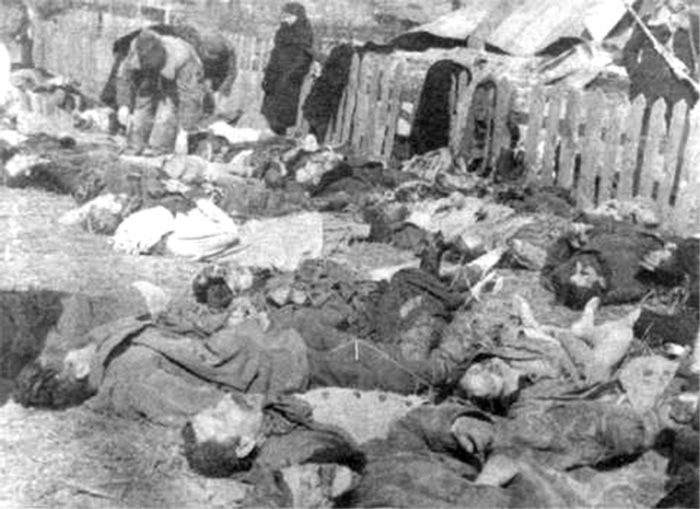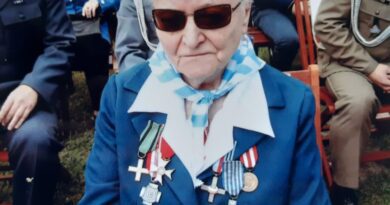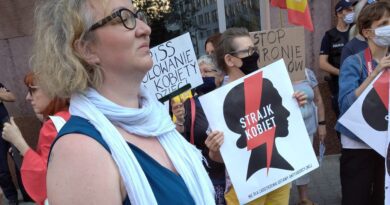Volhynian horror – a beastly genocide of Poles

Nationalists from the Ukrainian Insurgent Party (UPA) committed a beastly genocide of Poles. They wanted to create an ethnically clean Ukraine
Maciej Rosalak
Already in 1942 Poles were murdered but such ethnic cleansing – such “hygienic” term is used to describe real genocide committed (as in this case) because of victims ethnic origin – started in 1943.
It is believed to have started with the slaughter of Poles in Parośla in Sarneński Powiat by UPA sotnia under the command of Hryhorij Perehijniak “Dowbeszka-Korobka” on 9 February. A lucky survivor, 12-year boy, Witold Kołodyński after many years told the story how a visit of uninvited guests ended; they first hacked to death six prisoners, German collaborators, then they bit the father, and sat down to a dinner which they told the mother to prepare.
Escape from death by axe
“After a long time, the commander came to the bedroom with a satisfied grim, followed by a few bandits, laughing, undressed to their shirts. The commander told us: »You must lay down and we will bind you so that the Germans will not punish you for keeping and feeding partisans «. He ordered us to lie with faces to the ground, and then beastly murdering started, hacking our heads with axes. There were many murderers because we were murdered almost at the same time. The murderers stayed at our house, enjoying dinner. During the murder we heard mother’s cries; out of the corner of her eye she must have seen the murder of grandpa, grandma, father (her husband) because she was lying next to him. After a while she went quite. We – my sister and I – were lying further apart, near a cradle, our legs towards the parents’ heads. After some time I regained consciousness and heard Banderivtci in the kitchen, walking there and back. I was hearing my mum wheezing. To this day I do not know why I did not stand up. Then I heard steps and immediately returned to the same position. God’s will only. […] After dreadful silence I heard sounds of creaking sleighs, departing. I waited for some time and only then started to move. I was hurting, numb. My younger sister, Teresa, must have regained consciousness because she started to move, feeling the floor with her hand. I asked: »Lila, are you alive?«, to which my sister answered with surprise, or rather asked: »Why would I not be alive? Why are we lying on the floor?«. Then I told her that they had ordered us to lie down and they killed us all. I am injured, and hurting a lot. »I must be injured, too because my hair is sticky and my head hurts terribly«. We were freezing, numb, covered in blood. […] All people at our uncle’s household were also murdered. Opposite, at our neighbours’, the same view. Not a single living soul. Only dogs were howling hideously. No smoke from any chimney”.
Kill Polish gentry!
Such murders started in Eastern Volhynia, and then spread to the West, as far as Włodzimierz Volhyniaski. An outstanding expert on this subject – Ewa Siemaszko – found an apposite description of such tactics – a “moving hell”. It was like that: on the previous day and night, in total secret, UPA squads gathered in woods around a Polish village, armed to the teeth, also with machine guns, and with them were gangs of peasants. They were carried forks, axes, knives, hammers. They knew the area and their Polish neighbours well, so they first served as guides and later as executioners, who showed no mercy to the killed people, some of whom they knew since childhood. At dawn, gangs of murderers, some on horses, surrounded a village so that nobody could escape. Then a strike force would enter the village, and house after house murder anyone they found.
They perfidiously chose Sundays to catch Poles gathered for a mass in church and to be certain that nobody would be working in the field or in the forest. One such Sunday was 11 July 1943, when 99 villages and settlements inhabited by Poles were attacked. In Poryck 200 people were killed in a Roman Catholic church. the priest was captured and killed later. Murderers visited every house. To save bullets, they killed people with forks, axes and anything else they brought with them.
Iwan Hryń, captured by NKVD testified: “We had a heavy machine gun (Russian) and two small calibre mortars. At nigh we prepared ourselves and on the next day the whole gang, including me, attacked a Polish church, in which a mass was under way; some 200 hundred people were there, [including] elders and small children. The church was surrounded and the killing started, we fired from the machine gun through the main entrance and windows, as a result killing many people and children; those who were trying to escape were chased and killed. Then, a pogrom of individual families started, in which I also participated”.
In the village Gurów, only 70 out of 480 Poles survived; at Orzeszyn settlement, out of the total population of 340, 270 Poles were killed; in Sądowa village, out of 600 Poles, only 20 escaped death, at Zagaje settlement, a few out of 350 Poles survived. Stepan Redesz, a platoon commander, testified during the investigation: “We surrounded five Polish villages and during one night and the following day we burnt those villages to the ground and hacked all two thousand inhabitants to death. My platoon participated in burning one larger village, and the adjacent khutor. We slaughtered around one thousand Poles. Many of them – men, women, elders, children – we would throw alive to wells and then shoot. Others we stabbed with bayonets, hacked with axes and shot. We did it all under the motto: »Kill Polish Gentry which is coming to Ukrainian land «”.
Ewa Siemaszko writes (“Historia Do Rzeczy”, Issue No. 44, October 2016):
“The name for murders committed by Ukrainian nationalists in Volhynia – »Volhynia massacres« – was coined in 1943; later it was used to refer to extermination of Poles in East Galicia. The most common form of murder, hacking with axes, is only one of the macabre ways of killing. To depict the ordeal of Poles from Kresy (eastern borderlands of pre-war Poland), we must also mention other ways, such as splitting people open (also pregnant women), stabbing with forks and bayonets and leaving them to bleed out, cutting with a saw, cutting off noses, ears, tongues, plucking out eyeballs, tearing off nails, breaking hands and legs, cutting off breasts, strangling, binding with a wire and drowning restrained people in a river or a lake, staking through chest, dragging a man to death behind a horse, smashing children’s heads against walls and poles, tearing babies apart, spear children on fences, burying alive. […] Also Polish-Ukrainian families were exterminated – in whole or their Polish members only. Sometimes the Ukrainian family members were ordered to kill the Polish part of the family. During and after murders property was robbed, houses, sacral buildings, public utility buildings were destroyed, orchards were cut, cemeteries were destroyed (until today) – anything that could be a reminder of Poles who lived there.
Genocidum atrox
This happened in Volhynia, and later East Galicia, and later in Podkarpacie and Eastern Lublin Region. How many Poles were killed? Nobody can give the exact number. Conservative estimates speak about 100 thousand. Some reliable witnesses and researchers think there were many more – 130 thousand.
Eventually, Ukrainians were also killed, when finally consolidated troops of Polish underground resistance movement started – often to revenge their families – to attack Ukrainian villages. This encourages some Ukrainian historians to claim a symmetry between Ukrainian and Polish crimes. Death of innocent people, in particular, Ukrainian women and children, must pain any honest person, but there was no symmetry, no equivalence of those murders, not only because there were unproportionately – ten times – less Ukrainian victims. The difference is that UPA attacked first and for a long time was practically unpunished. The two phenomena differ by the fact that a genocidal order was issued by Klaczkiwski, approved by Suchewycz and at least acknowledged by OUN (Organization of Ukrainian Nationalists) and followed – after Volhynia – also in East Galicia. No written record of such OUN’s decision exists, but it is more than sufficiently demonstrated by horrific crimes committed by Ukrainian nationalists. And Klaczkiwski – according to the testimony of Jurij Stelmaszczuk „Turiw” – in June 1943 issued a secret directive: “We should carry out a massive action of exterminating the Polish element. After German army leaves, we should take advantage of such convenient time to eliminate all men from 16 to 60 years old… We cannot lose this fight and Polish forces must be weakened at any price. Forest villages and villages next to the woods should disappear from the surface of the earth”. What he said, his people did. Those villages do not exist anymore. And after later depatriation of Poles by the Soviets, the Polishness disappeared from those lands after six centuries of presence. At the end, I would like to quote Ewa Siemaszko once again:
“Such planned action of physical extermination of Poles as an ethnical group, organized by OUN and carried out by UPA and supporting Ukrainian groups, qualifying as genocide in the light of the »Convention on the Prevention and Punishment of Crime of Genocide« of 1948, was exceptional because of the scale and the cruel treatment of victims. This was genocidum atrox, i.e., a barbarian genocide, savage, particularly beastly”.
From Russia to Ukraine
Genocide of Poles by Ukrainians during World War II may horrify and come as a shock. The scale of beastliness and number of victims were connected here not only with the murderous plan concocted in the sick minds of murder instigators, but also eager co-participation in the crimes of a large part of the Ukrainian population of Volhynia and East Galicia.
And yet Ukrainian and Poles used to live here side by side. Volhynia together with the whole Ukraine was annexed to the Kingdom of Poland in the 14th century, at the times of the Polish king Sigismund Augusts, when the Russian gentry opted for the annexation at the time when the Union of Lublin was signed (1569). However, in the Red Ruthenia, later known as East Galicia, the Polish king Casimir the Great ruled already two centuries before as a result of dynastic arrangements. Following the Partitions of Poland at the end of the 18th century, Volhynia came under the Russian rule, and East Galicia – under Austrian rule.
The history of the people of Volhynia had its tragic turns, for instance, during the Cossack rebellion in the 17th century or Haidamaky rebellion in the 18th century, as well as during Ukrainian-Polish fights in the years 1918–1919. Yet, in 1920 Ukrainian and Poles were brothers in arms, countering Bolshevik invasion. The agreement between the Polish Chief of State Józef Piłsudski and the Ukrainian leader Symon Petlura assumed that both East Galicia and Volhynia will be incorporated into Poland. And so it happened, but in spite of temporary takeover of Kiev, it was not possible to win independence for Ukraine.
Ukrainians’ understandable disappointment manifested in many ways in the lands incorporated into Poland. A large part of their intellectuals and leaders were seeking a way for their nation’s development in cooperation with the Polish state, finding understanding of such Polish politicians as Tadeusz Hołówko, MP, Bronisław Pieracki, Minister of Internal Affairs and Henryk Józewski, Volhynia Voivod. The Polish-Ukrainian agreement program, implemented by Voivod Józewski, was not, however, supported by the Polish government, which (in particular, after Piłsudski’s death) organized repressions of Ukrainian terrorists, which unfortunately affected also the peaceful part of the Ukrainian population.
However, those terrorists, following orders from the Organization of Ukrainian Nationalists, created in 1929, set fires to houses and crops of Polish peasants, attacked public officers and murdered those who, in their opinion, were an obstacle to the creation of the independent Ukrainian state. And this meant advocates of dialogue and cooperation on both sides. So they murdered Hołówka (1931) and Pieracki (1934), and were preparing Józewski association, but among their victims was also Iwan Babij – the director of Ukrainian Gymnasium in Lwów. In the years 1921–1939, Ukrainian nationalist underground movement organized 63 assassinations, which claimed the lives of 36 Ukrainians (of which only one communist), 25 Poles, one Russian and one Jew. Besides 63 association attempts (of which 11 against well-known Polish and Ukrainian politicians, eight of which were successful), during the period between the two world wars also five bomb attacks and 18 expropriation actions were undertaken.
It is important to note that the last commandment of the “Decalogue of Ukrainian Nationalist” formulated in 1929 was: “You will not hesitate about committing the worst crimes if the cause so requires. You will show hatred and deceit towards the enemies of your Nation. You will endeavour to increase the power, fame, riches and lands of the Ukrainian State even by conquering foreigners”. Those commandments were particularly carefully followed by Stepan Bandera, who in the first half of the 1930s had the function of the prowidnyk (leader) of the domestic OUN. It was then when most honourable people lost their lives at the hands of nationalist armed groups.
They smelled blood…
Nationalists smelled blood at the beginning of the war in 1939. Together with communist fighting groups they attacked Polish Army units fighting with Germans, and after 17 September, also opposing the Soviets. When it turned out that Ruthenia lands will be under the Soviet occupation, there was a split in OUN. At the beginning of April 1940, those in support of strict cooperation with Germans grouped around Andrij Melnyk (who, by the way, was an Abwehra agent) and created the so-called OUN-M. The other group led by Stepan Bandera created OUN-B, which paid more attention to creating armed forces and to exterminations. That way the National Military Headquarters and OUN Military Centre were established.
After Third Reich’s attack on the USSR in 1941, when nationalists hoped that Nazis would create an Ukrainian state, they eagerly collaborated. They participated in creating murderous battalions Nachtigall and Roland under the SS auspices, and the police, in murdering Polish intellectuals from Lwów and extermination of Jews – extermination which then started to have the form of mass murders. Polish historians note that holocaust in Ukraine caused OUN to finally abandon the basic moral rules, gather experience in mass execution methods, and get the approval of a major part of the population for the use of such methods.
Old Haidamaky motto: “Attack polish gentry, Latin priests and Jews” was only slightly changed to “Attack Poles, Jews and communists”. Poles were no longer only gentry and priests, but first of all, if not only, peasants. Neighbours of Ukrainian peasants, who were the same as they were, and with whom – according to dozens of testimonies – they previously lived in accord, often intermarrying and helping each other. That was before fascist illusions of nationalists poisoned kin blood…
When Germans ignored the ambitions for “samostijna Ukrajina”, Bandera revoked his alliance with them and started to create his own partisan groups. In September 1941, he was arrested and imprisoned in Sachsenhausen (where, by the way, he came to no harm). On 14 October 1942, Military Functionaries of OUN-B regional boards created armed forces, which at the end of 1943 adopted a single name for Volhynia and East Galicia – Ukrainian Insurgent Party (UPA). It had 15 thousand soldiers, and a year later, during the full mobilization and concurrent fighting with the Soviets and the Polish Home Army (AK) – even 35 thousand. Since at the turn of 1942 and 1943, following OUN’s orders, Ukrainians deserted the collaborating police, UPA had many trained people and good weapons. They were supported by the “black mob”, that is, local Ukrainian peasants.
The first commander for Volhynia was Dmytro Klaczkiwski “Kłym Sawur”, soon the main executioner of the Polish population in Volhynia. The political and military leader was Roman Szuchewycz, OUN-B prowidnyk, appointed a general, not long before, a soldier of the Nachtigall battalion and German schutzmann. In Poland and adjacent areas, twelve military districts were created. They were divided into regiments (partyzanckie zahiny), composed of kureni (battalions), sotni (companies), czots (platoons), rojs (teams) and łanek (sections).
UPA sometimes even organized actions against Germans, but – in line with the plan – turned against Poles. They were to immediately leave the land, where they had lived for many generations, and if they failed to listen to this command, death awaited them. And not only men, but also women and children. They were to be killed in such a way that they would feel they were dying…”
This article was published in “Do Rzeczy” magazine in 2016.



